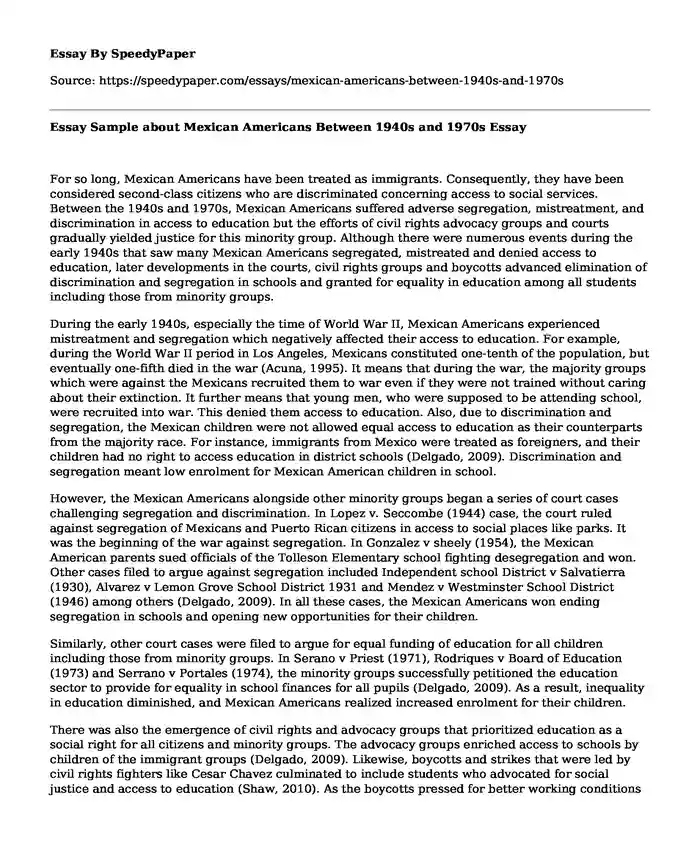
| Type of paper: | Essay |
| Categories: | Racism Discrimination |
| Pages: | 3 |
| Wordcount: | 687 words |
For so long, Mexican Americans have been treated as immigrants. Consequently, they have been considered second-class citizens who are discriminated concerning access to social services. Between the 1940s and 1970s, Mexican Americans suffered adverse segregation, mistreatment, and discrimination in access to education but the efforts of civil rights advocacy groups and courts gradually yielded justice for this minority group. Although there were numerous events during the early 1940s that saw many Mexican Americans segregated, mistreated and denied access to education, later developments in the courts, civil rights groups and boycotts advanced elimination of discrimination and segregation in schools and granted for equality in education among all students including those from minority groups.
During the early 1940s, especially the time of World War II, Mexican Americans experienced mistreatment and segregation which negatively affected their access to education. For example, during the World War II period in Los Angeles, Mexicans constituted one-tenth of the population, but eventually one-fifth died in the war (Acuna, 1995). It means that during the war, the majority groups which were against the Mexicans recruited them to war even if they were not trained without caring about their extinction. It further means that young men, who were supposed to be attending school, were recruited into war. This denied them access to education. Also, due to discrimination and segregation, the Mexican children were not allowed equal access to education as their counterparts from the majority race. For instance, immigrants from Mexico were treated as foreigners, and their children had no right to access education in district schools (Delgado, 2009). Discrimination and segregation meant low enrolment for Mexican American children in school.
However, the Mexican Americans alongside other minority groups began a series of court cases challenging segregation and discrimination. In Lopez v. Seccombe (1944) case, the court ruled against segregation of Mexicans and Puerto Rican citizens in access to social places like parks. It was the beginning of the war against segregation. In Gonzalez v sheely (1954), the Mexican American parents sued officials of the Tolleson Elementary school fighting desegregation and won. Other cases filed to argue against segregation included Independent school District v Salvatierra (1930), Alvarez v Lemon Grove School District 1931 and Mendez v Westminster School District (1946) among others (Delgado, 2009). In all these cases, the Mexican Americans won ending segregation in schools and opening new opportunities for their children.
Similarly, other court cases were filed to argue for equal funding of education for all children including those from minority groups. In Serano v Priest (1971), Rodriques v Board of Education (1973) and Serrano v Portales (1974), the minority groups successfully petitioned the education sector to provide for equality in school finances for all pupils (Delgado, 2009). As a result, inequality in education diminished, and Mexican Americans realized increased enrolment for their children.
There was also the emergence of civil rights and advocacy groups that prioritized education as a social right for all citizens and minority groups. The advocacy groups enriched access to schools by children of the immigrant groups (Delgado, 2009). Likewise, boycotts and strikes that were led by civil rights fighters like Cesar Chavez culminated to include students who advocated for social justice and access to education (Shaw, 2010). As the boycotts pressed for better working conditions for workers, so was the advancement towards access to education by the children of those workers who were mostly immigrants from Mexico.
The struggle by civil rights advocates through boycotts and court cases played a significant role in advancing for access to education by the Mexican American children between 1940s and 1970s. The successful court cases eliminated segregation and discrimination within the schools urging for integration of all learners whereas other cases established for equity in funding of education for all learners including those from minority groups. Boycotts advocated for social justice including education as a priority area.
References
Acuna, R. (1995). Early Chicano activism: Zoot suits, sleepy lagoon, and the road to Delano. The Latino condition: A critical reader, 309-319.
Delgado, R. (2009). The law of the noose: A history of Latino lynching. Harv. CR-CLL Rev., 44, 297.
Shaw, R. (2010). Beyond the Fields: Cesar Chavez, the UFW, and the Struggle for Justice in the 21st Century. Univ of California Press.
Cite this page
Essay Sample about Mexican Americans Between 1940s and 1970s. (2022, Apr 07). Retrieved from https://speedypaper.com/essays/mexican-americans-between-1940s-and-1970s
Request Removal
If you are the original author of this essay and no longer wish to have it published on the SpeedyPaper website, please click below to request its removal:
- Comparison Essay Sample: Renting Vs Owning
- Free Essay on Bible's Prohibition Against Graven Images
- Creative Writing Essay Sample: Life in Wheels, Stephanie's Story
- Why Lack of Literacy Is a Problem - Cause and Effect Essay
- Paper Example. Communication Within Organizations
- Free Essay. the Construction Industry and Its Environmental Impact on Water Quality
- Essay Example: Advocacy Through Legislation
Popular categories




